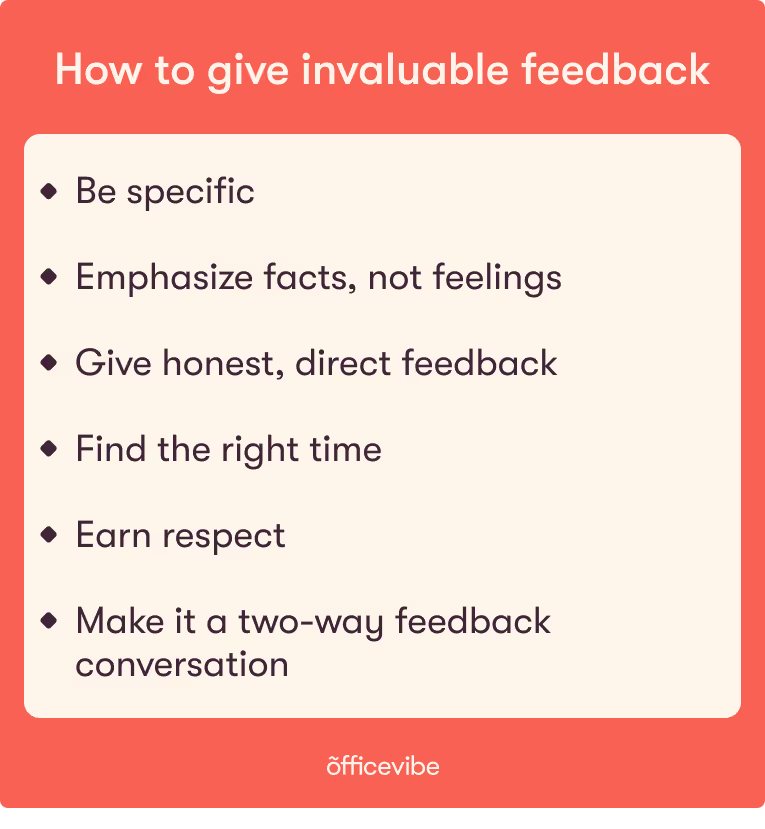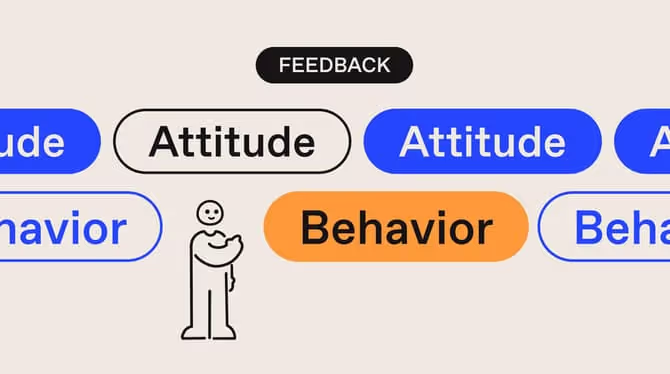How to give effective employee feedback

Discover Workleap Officevibe's benchmark report on 12 key employee engagement metrics

Let's face it: giving employee feedback can be challenging. From having difficult conversations about performance to making one-on-one feedback more effective, you have to juggle choosing the right time, delivery method, and strategic approach.
Team leaders have the crucial (and sometimes stressful) role of giving real-time feedback to employees in a way that will help them develop their expertise, work collaboratively and effectively, and earn respect.
Great leaders understand that giving employee feedback is essential for ongoing workplace development. Feedback conversations improve employee performance, provide valuable insights, and facilitate efficient teamwork.
The "why" solicit feedback as part of performance management can be crystal clear. Yet the "how" can be more daunting...until now.
Read on to learn how to provide employee feedback to improve the work experience for everyone.
Why it's important to give employee feedback
Employees want feedback because it helps them know what they're doing well and where they can improve. Ultimately, providing continuous constructive feedback to employees helps them develop in their role, which is one of the top factors determining long-term engagement and retention.
According to Officevibe's Pulse Survey data:
- 1 in 4 employees say they don't receive feedback often enough to understand how they can improve;
- 1 in 5 employees aren't satisfied with how often they get feedback from their direct manager;
- Employees who do receive feedback say that it helps them grow and develop. These employees also tend to report a better working relationship with their manager.
Discover more on the importance of employee feedback and some related statistics of employee feedback.
6 ways to give effective and constructive employee feedback
Providing constructive feedback is one of the best ways to cultivate stronger relationships, spark employee engagement, and retain employees.
But where should team leaders start? Don't worry. We've got you. Here are six tips on giving effective employee feedback, from communication skills and delivery to timing and tone.
Give specific feedback
According to Officevibe's Pulse Survey software, one in three employees say the feedback they receive at work isn't super-specific. Team leaders should avoid being vague and affirm actions they want to see repeated.
Research in the Journal of Applied Psychology backs that finding and shows that the best way to improve performance when giving feedback is to make it specific and tie it to a specific goal. Next time goals come up in your employee's performance reviews, keep this in mind! Without a specific goal, it becomes hard to evaluate the effects of behavior change properly.
Pro-tip: Officevibe's goal-setting agenda makes setting and tracking goals with each member of your team easy. Work together to draft personal goals for each employee based on the SMART model, all in the app!
Emphasize facts, not feelings
People need manager feedback to grow and develop. But if the delivery feels like an attack, team members are more likely to get defensive and shut down when receiving feedback. Sticking to the facts and keeping a professional tone is crucial to providing constructive, valuable feedback that sticks.
💡Check out our top 12 manager feedback examples.
When it comes to giving negative feedback, The Harvard Business Review recommends starting the conversation by noting exactly when and where the behavior you want to discuss occurred. Describe in detail what you saw and heard. Describe your reaction to the behavior.
A fact-based, non-judgmental approach means the employee is less likely to get defensive and more likely to consider your feedback seriously.
Give honest, direct feedback
An important part of giving constructive feedback is simply being honest and direct. To soften negative feedback, managers will often adopt "the sandwich approach," where you put feedback between two pieces of praise to make the feedback sound less harsh.
But this often doesn't work.
Research shows that a straightforward, direct approach will make employees more likely to listen to their feedback.
Want to put this into action? Learn how to give feedback with these 5 best practices for managers
Find the right time
Timing is key for effective communication. Finding the right time to provide feedback is one of the most important things to consider. In most situations, the best time to give employee feedback is soon after the incident has occurred.
The longer you wait to give feedback, the longer you will be affected by what you didn't share with your employee—and the longer your employee's actions will remain the same.
What if the feedback is negative or high-stakes? Set aside deliberate time to ensure both you and your direct report are in an empathetic, prepared state.
A regular one-on-one is a good time for this type of constructive feedback. A staff meeting where other team members are present might not be.
Looking forward to give constructive feedback right on time? Check out the constructive feedback examples & tips for managers
Earn respect
While it may seem obvious, treating your team members with respect is one of the best ways to earn their respect. And no matter how structured or polite your feedback is, an employee won't listen to it if they don't respect you.
Employees who say that their manager is respectfully giving feedback, also believe that their manager cares about their opinion. Sadly, only 43% of employees say feedback is given in a truly respectful manner.
According to the American Psychological Association, a team leader must be seen as a "credible source of advice." If not, you won't be listened to.
Employees need to feel as if you have their best interests at heart. Earning respect takes time, but it's clutch to garner that positive interaction and positive behavior you're looking to get from your feedback.
Make it a two-way feedback conversation
It can be difficult to get people to accept feedback, especially when it's negative. Instead of resorting to the aforementioned "sandwich approach," the Harvard Business Review recommends having performance conversations powered by teamwork.
Rather than relying on a feedback hierarchy, the article states, team leaders should consider a model that increases two-way conversation with employees.
[ov_cta id="5116548"]
For example, managers can ask employees to give themselves feedback on their own work. Ask them something like, "How do you think that went? Was there anything you think you could improve on for next time?" Our classic one-on-one template suggests prompts for everything from setting employee goals to checking in and setting action items.
The right one-on-one template helps make every conversation focused and productive, fostering trust and setting the conditions for positive, lasting change.

Balancing positive and negative feedback
Maintaining a healthy balance is crucial when providing feedback. According to the Center for Creative Leadership (CCL) research, negative and positive feedback are essential to helping managers offer support. Leaders who excel know how to enhance their employees' best qualities while also addressing those that need work.
Negative feedback
Giving negative feedback or constructive criticism can be daunting, but great leaders know it's crucial to helping team members meet their performance goals, despite the strong emotions that can arise.
Critical feedback should offer someone a perspective on behavior or action to help them improve. According to the CCL, practical criticism needs to be delivered with respect and care. Frequent or exclusively negative comments can spark defensive reactions that dampen motivations.
Positive feedback
We all need a pat on the back every once in a while. Recognizing the strengths in a workplace and showing appreciation for your employees and colleagues is equally important to workplace development and ongoing learning.
Managers can provide support by giving recognition and telling their team members they did a great job. Providing positive feedback can set the scene for further effective feedback conversations.
Constructive feedback
When managers provide positive feedback and provide negative feedback to have a two-way conversation with their employees, they help employees grow, support them toward their goals and build on their strengths. According to the CCL, you'll foster more learning by asking questions that stimulate reflection and coaching people into exploration and experimentation.
Employee feedback can take many forms. It can be informal, like a simple "good job!" after a team member's presentation, or more formal, like written feedback during an annual performance review. To get a complete picture, you may even want to get feedback from other team members via a 360-degree feedback format.
Looking for more constructive employee feedback examples? Here are our top employee feedback examples for real-life situations
How Pulse Surveys create a strong feedback culture
Giving feedback is a crucial skill for a manager aiming to help everyone on their team reach those growth goals. It's an opportunity for you to demonstrate your investment in the professional development of your team members.
[ov_cta id="5116548"]
A key part of maintaining your team's health and improving as a manager is getting employee feedback. Establishing effective feedback channels makes it easier to keep up with what's enabling or blocking your team's success.
Here's another way of looking at the feedback loop:
When employees give feedback, it helps employee experience.
When managers give feedback, it helps the team and individual employees.
The more feedback exchange of give-and-receive, the more you set a tone for a solid and receptive feedback culture. Over time, the more this culture gets integrated into the day-to-day.
Pro-tip: Show employees you're open and interested in their feedback by sending Pulse Surveys. These short, 2-minute, anonymous weekly surveys give your team a safe space to share their thoughts and make it easier for leaders to take action.
Prioritizing employee engagement and satisfaction
Employee pulse surveys are the best and the most accurate way to measure employee engagement levels and job satisfaction. Getting anonymous written feedback in each survey can open up discussions you might not have otherwise. And from there, you can offer your support and give positive feedback where it counts. Being open and adaptive to the needs of your team and making employee satisfaction a priority is what distinguishes a good leader from a great one.
Give HR and managers the clarity, confidence, and connection to lead better every day.


%20(1).avif)


.avif)
.avif)

.avif)






